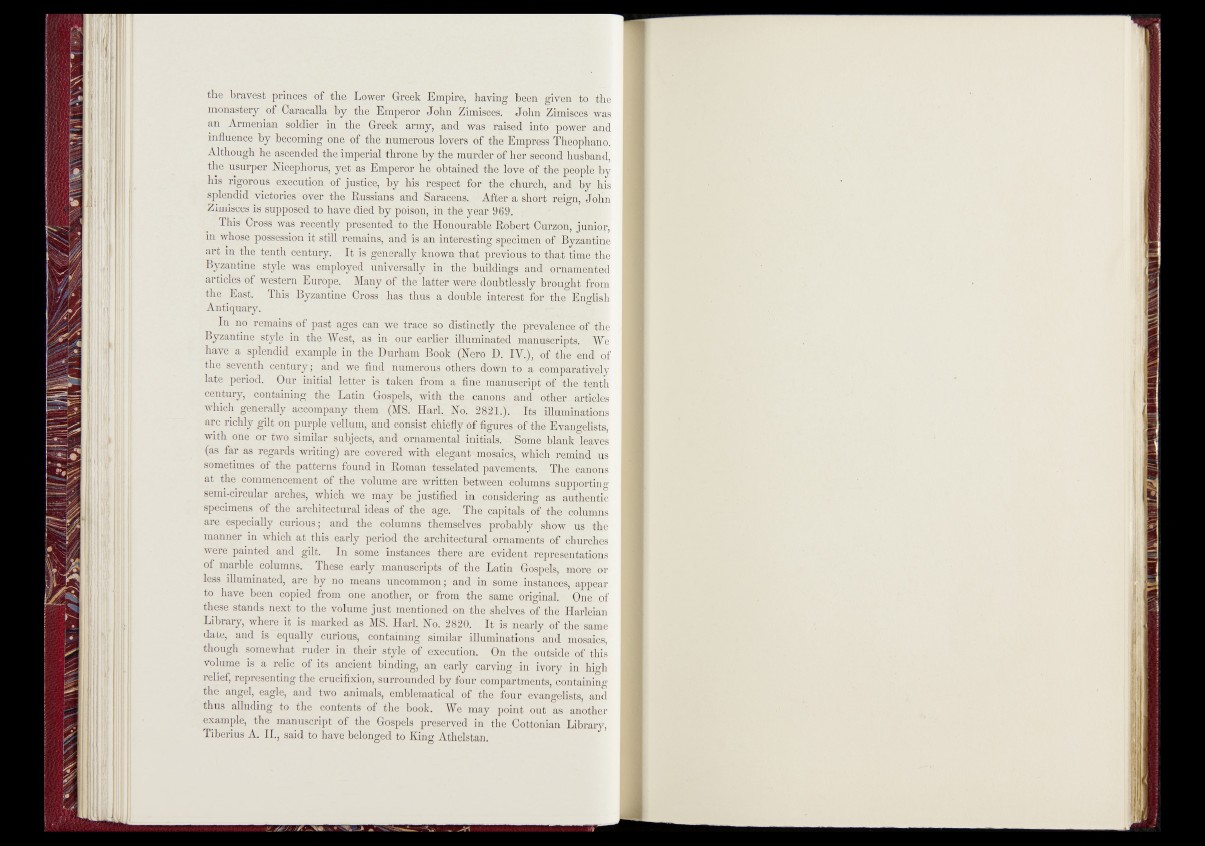
the bravest princes of the Lower Greek Empire, having been given toffihe
monastery of Caracalla by the Emperor John Zimisces. John Zimisces Bas
an .Armenian soldier in the Greek army, and was raised into power îfând
influence by becoming one of the numerous lovers of the Empress Theophanó.
Although he ascended the imperial throne by the murder of her second hus band,
the usurper Nicephorus, yet ' as Emperor he obtained the loye' of, the people by
his rigorous éxecution of justice, by his respect for the church, and by his
splendid victories over the Russians and Saracens. After a short reign, John
Zimisces is supposed to have died by poison, in the year 969.
^ . This Gross , was recently presented'to the Honourable Robert Curzon, junior,
*n "^bose possession it still remains, and is an interesting specimen of Byzantine
art in the tenth century. It is generally known that previous to that time^the
Byzantine style was employed universally in . the buildings and ornamented
arthdes^pf ^western Europe. Many of'therlatter werè-âoubtJësslylb’rQught .from
.the East This Byzantine Gross has thus a double interest for the .English
Antiquary.
In no remains of past ages can we trace so distinctly the. prevalence o’flthe
Byzantine style in. the-West,. as in.our earlier illuminated manuscripts. fYe
bave a splendid example in the Durham Book (itero D. IY.), of the en |‘ of
;the seventh century ; and we find j numerous ’others fio3vn to h-nomparatifoy
late period. Our initial letter is taken from a fine manuscript pf; the' .tilth
century, containing the Latin Gospels, with the,- canons and -other—Ahdcles
which generally accompany them (MS. Harl._JTo. Its illuminat&ms
are richly gilt on purple vellum, and consist chiefly of figures-of jMe Evangelists,
with one or two similar rabjéç%>nd ' omajnéntal hntials. -,Some blank lefres
(as far as regards .writing) are covered with elegant’-mpsaics, which remind us
sometimes of the patterns found in Roman-tesselated pavements. The batons
at thé commencement of the volume are writténNbetWeen~c'olùmns g-up^ftno-
semi-circular arches, which we may be justified in considering as authentic
specimens of the architectural ideas of the age. The capitals, of-the “columns
are especially curious ; and the columns themselves- profeàbly- show us She
manner in which at this early period the architectural Ornaments of churches
were painted, and gilt. In some” instances there are evident representations
of marble columns. These early manuscripts of the Latin Gospels, more or
less illuminated, are by no means uncommon ; and in some instances, appear
to have been copied-from one another, or from the same original. One" of
these stands next to the volume just mentioned on the shelves ofthe Harleian
Library, where it is marked as MS. HarL'No. 2820. It is nearly of the. same
date, and is. equally curious, containing similar illuminations and mosaics,
though somewhat ruder in their style of execution. On the outside of this
volume is a refiç; of its ancient binding, an early carving -in ivory in high
relief, representing the crucifixion, surrounded by four compartments, containing
thé angel, eagle, and two animals, emblematical of the four evangelists, and
thus alluding to the contents of the book. We may point out as another
example, the manuscript of the Gospels preserved in the Cottonian Library.
Tiberius A. IL, said to have belonged to King Athelstân.